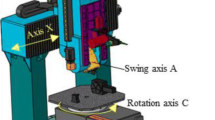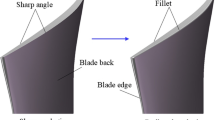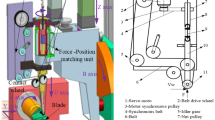Abstract
As for blisk blade profile polishing, the “five-axis numerical control + flexible grinding head + elastic grinding tool” polishing process equipment has advantages of high precision, little interference, good adaptivity, etc.; in order that the elastic grinding tool (abrasive cloth wheel) can effectively fit in with the blade profile in the polishing process and polishing quality and efficiency can be improved, a polishing path programming method of the elastic grinding tool was studied, feed mode of the elastic grinding tool and parametric method of the blade profile were proposed, and calculation methods of offset surface, polishing spacing, polishing step size and cutter-axis vector were given; this polishing path programming method makes it possible for the flexible spindle mechanism keeps a reasonable pose during the polishing process so that the elastic grinding tool can not only effectively fit in with the blade profile but also the polishing force direction of the elastic grinding tool is basically identical with normal vector direction of the polishing point; the polishing test results indicate that: After polishing, blade surface roughness is smaller than 0.4 μm and blade profile tolerance is within the tolerance zone, thus satisfying technical requirements and indicating that the technology proposed in this paper can satisfy blisk blade profile polishing requirements.
Similar content being viewed by others
References
W. B. Huai, Y. Y. Shi, H. Tang and X. J. Lin, Sensitivity of surface roughness to flexible polishing parameters of abrasive cloth wheel and their optimal intervals, Journal of Mechanical Science and Technology, 31 (2) (2017) 865–873.
G. J. Xiao and Y. Huang, Equivalent self-adaptive belt grinding for the real-R edge of an aero-engine precisionforged blade, International Journal of Advanced Manufacturing Technology, 83 (9-12) (2016) 1697–1706.
H. Huang, Z. M. Gong and X. Q. Chen, Robotic grinding and polishing for turbine-vane overhaul, Journal of Materials Processing Technology, 127 (2) (2002) 140–145.
M. Bigerelle, A. Gautier, B. Hagege and B. Bounichane, Roughness characteristic length scales of belt finished surface, Journal of Materials Processing Technology, 209 (20) (2009) 6103–6116.
W. H. Ho, J. T. Tsai, B. T. Lin and J. Chou, Adaptive network- based fuzzy inference system for prediction of surface roughness in end milling process using hybrid Taguchigenetic learning algorithm, Expert Systems with Applications, 36 (2) (2009) 3216–3222.
P. B. Zhao and Y. Y. Shi, Composite adaptive control of belt polishing force for aero-engine blade, Chinese Jounal of Mechanical Engineering, 26 (5) (2013) 988–996.
G. J. Xiao, Y. Huang and G. L. Chen, Investigations on belt grinding of GH4169 nickl-based superalloy, Advanced Materials Research, 1017 (2014) 15–20.
G. J. Xiao, Y. Huang and Y. Yang, Workpiece surface integrity of GH4169 nickl-based superalloy when employing abrasive belt grinding method, Advanced Materials Research, 936 (2014) 1252–1257.
Y. Huang, L. Zhang, Z. Huang and Q. Guo, Experimental analysis of the abrasive belt follow-up grinding of Zirconium- 4 alloys tubes and pipes, Journal of Chongqing University, 35 (10) (2012) 30–37 (in Chinese).
G. L. Wang, Y. Q. Wang, L. Zhang and H. B. Zhou, Development and polishing process of a mobile robot finishing large mold surface, Machining Science and Technology, 18 (4) (2014) 603–625.
J. J. Marquez, J. M. Perez, J. J. Rios and A. Vizán, Process modeling for robotic polishing, Journal of Materials Processing Technology, 159 (1) (2005) 69–82.
J. Chaves-jacob, J. M. Linares and J. M. Sprauel, Control of the contact force in a pre-polishing operation of free-form surfaces realised with a 5-axis CNC machine, CIRP Annals-Manufacturing Technology, 64 (1) (2015) 309–312.
D. H. Zhu, S. Y. Luo, L. Yang and W. Chen, On energetic assessment of cutting mechanisms in robot-assisted belt grinding of titanium alloys, Tribology International, 90 (2015) 55–59.
G. J. Xiao and Y. Huang, Constant-load adaptive belt polishing of the weak-rigidity blisk blade, International Journal of Advanced Manufacturing Technology, 78 (9-12) (2015) 1473–1484.
R. Pan, Z. Z. Wang, C. J. Wang, Y. H. Xie, D. X. Zhang and Y. B. Guo, Research on control optimization for bonnet polishing system, International Journal of Precision Engineering and Manufacturing, 15 (3) (2014) 483–488.
S. Y. Zeng and L. Blunt, Experimental investigation and analytical modelling of the effects of process parameters on material removal rate for bonnet polishing of cobalt chrome alloy, Precision Engineering, 38 (2) (2014) 348–355.
Y. Q. Wang, S. H. Yin, H. Huang, F. J. Chena and G. J. Deng, Magnetorheological polishing using a permanent magnetic yoke with straight air gap for ultra-smooth surface planarization, Precision Engineering, 40 (1) (2015) 309–317.
E. S. Lee, S. G. Lee, W. K. Choi and S. G. Choi, Study on the effect of various machining speeds on the wafer polishing process, Journal of Mechanical Science and Technology, 27 (10) (2013) 3155–3160.
Z. W. Zhong, Recent advances in polishing of advanced materials, Materials and Manufacturing Processes, 23 (5) (2008) 449–456.
M. Givi, A. F. Tehrani and A. Mohammadi, Polishing of the aluminum sheets with magnetic abrasive finishing method, International Journal of Advanced Manufacturing Technology, 61 (9-12) (2012) 989–998.
M. Li, B. H. Lyu, J. L. Yuan, C. C. Donga and W. T. Dai, Shear-thickening polishing method, International Journal of Machine Tools & Manufacture, 94 (7) (2015) 88–99.
W. B. Huai, H. Tang, Y. Y. Shi and X. J. Lin, Prediction of surface roughness ratio of polishing blade of abrasive cloth wheel and optimization of processing parameters, International Journal of Advanced Manufacturing Technology, 90 (1) (2017) 699–708.
J. F. Zhang, Y. Y. Shi, X. J. Lin and Z. S. Li, Five-axis abrasive belt flap wheel polishing method for leading and trailing edges of aero-engine blade, International Journal of Advanced Manufacturing Technology, 93 (9-12) (2017) 3383–3393.
J. F. Zhang, Y. Y. Shi, X. J. Lin and Z. S. Li, Parameter optimization of five-axis polishing using abrasive belt flap wheel for blisk blade, Journal of Mechanical Science and Technology, 31 (10) (2017) 4805–4812.
J. H. Duan, Y. M. Zhang and Y. Y. Shi, Belt grinding process with force control system for blade of aero-engine, Proceedings of the Institution of Mechanical Engineers Part Bjournal of Engineering Manufacture, 230 (5) (2016) 858–869.
E. Brinksmeier, O. Riemer and A. Gessenharter, Finishing of structured surfaces by abrasive polishing, Precision Engineering, 30 (3) (2006) 325–336.
Y. Q. Sun, D. J. Giblin and K. Kazerounian, Accurate robotic belt grinding of workpieces with complex geometries using relative calibration techniques, Robotics and Computer-Integrated Manufacturing, 25 (1) (2009) 204–210.
Y. J. Shi, D. Zheng, L. Y. Hu and Y. Q. Wang, NC polishing of aspheric surfaces under control of constant pressure using a magnetorheological torque servo, International Journal of Advanced Manufacturing Technology, 58 (9-12) (2012) 1061–1073.
Z. J. Yang, F. Chen, J. Zhao and X. J. Wu, A novel vision localization method of automated micropolishing robot, Journal of Bionic Engineering, 6 (1) (2009) 46–54.
C. Tournier and E. Duc, A surface-based approach for constant scallop heighttool-path generation, The International Journal of Advanced Manufacturing Technology, 19 (5) (2002) 318–324.
C. Walter, M. Rabiey, M. Warhanek and N. Jochum, Dressing and truing of hybrid bonded CBN grinding tools using a short-pulsed fibre laser, CIRP Annals - Manufacturing Technology, 61 (1) (2012) 279–282.
Acknowledgments
This work is supported by the Key Laboratory of Contemporary Design and Integrated Manufacturing Technology Ministry of Education, China.
Author information
Authors and Affiliations
Corresponding author
Additional information
Recommended by Associate Editor Seok-min Kim
Wenbo Huai received master’s degree in engineering from Xi’an University of Technology in 2009 and doctorate of engineering from Northwestern Polytechnical University in 2018. China. Mr. Huai is currently an Associate Professor at the School of High Vocational Education at Xi’an University of Technology in Xi’an, China. His research fields is adaptive polishing technique for complex surface.
Rights and permissions
About this article
Cite this article
Huai, W., Shi, Y., Tang, H. et al. An adaptive flexible polishing path programming method of the blisk blade using elastic grinding tools. J Mech Sci Technol 33, 3487–3495 (2019). https://doi.org/10.1007/s12206-019-0643-0
Received:
Revised:
Accepted:
Published:
Issue Date:
DOI: https://doi.org/10.1007/s12206-019-0643-0




